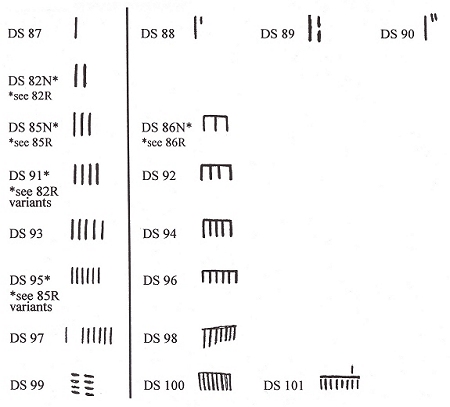

Patrocinio del
Comune di Roma
Dipartimento XIV
Comune di Roma
Dipartimento XIV
by Shan M. M. Winn
The first set of possible numerals (DS 87-101) involves simple straight lines and suggests a simple counting system. Although used throughout the Vinça culture, they are markedly more frequent at Turdaş. Numbers higher than 6 are infrequent; the use of eight lines can be represented as two groups of four lines (DS 99) and may reflect two groups of (2 + 2) lines (see DS 82R variant), or a doubling of the four lines that commonly appear on figurines and ritual artifacts. An interesting use of eight lines is found on DS 101: eight lines are inscribed on one side of a bar, and a 9th line is placed on the opposite side of the bar. Could this be evidence for an unusual system based on 16 (or 8, probably the highest number generally used)? * Signs DS 82N, 83N and 86N are identical with signs (Category IV) DS 82R, 83R and 86R except for usage. N=Numerical use; R= Ritual use. Core signs 
The second set (DS 102-109) of numerals may have been used exclusively at Turdaş. Perhaps restricted to numeration, the dot-like marks (representing 10?) were possibly used in simple economic contexts. Note the neatly arranged sets of six and twelve marks (DS 107-108). Core signs 
This set of signs (DS 110-115) may not represent numerals, as they have complex variations, and the method of marking "multiple" is the same as, for example, a multiple "V". Such signs possibly represent a form of record keeping or tallies. Core signs 
Basal signs DS 118-124 may be representations of owners' houses: two parallel lines marking the structure (DS 119-121) suggest the presence or protection of the goddess in a particular household.  | ||||||||
| 1 | 2 | 3 | 4 | 5 |